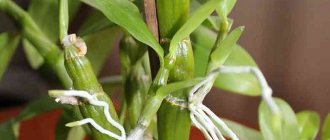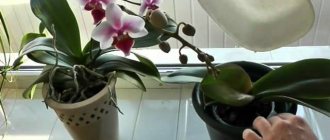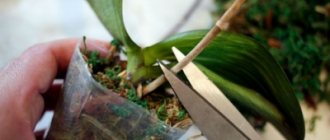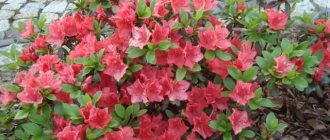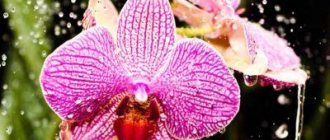Orchid is a flower plant that is bought by millions of housewives all over the planet. But beauty requires sacrifice, because caring for this crop at home during flowering is very difficult. If you approach breeding responsibly, then exotics will delight you with budding. The flower, if cared for, can bloom 2 times a year: in autumn and spring. This is a rather capricious crop; it can bloom a second time only if a number of care rules are followed. The plant loves a lot of space, which flower breeders are not always informed about.
What happens to a plant when it blooms?
Orchids can bloom at any time of the year . To do this, you just need to meet certain conditions. The duration of flowering can reach three months, although there are cases where orchids have been pleased with flowers for five or even eight months. The flowering process begins with the growth of a long peduncle that develops over two months. Then buds appear on it, which subsequently bloom.
Differences in care during and after buds open
At each period of development, the orchid needs certain care.
When it just begins to gain strength for the development of the peduncle, special feeding is important to help the flower develop faster.- The process of watering during the flowering period and during the dormant period is characterized by abundance: as soon as the room becomes cool, the amount of water is reduced (you can find out how to properly organize care if the orchid has bloomed here).
- After flowering, the plant needs pruning. You can replant indoor crops only after the end of this period.
Pollination process
Using a toothpick or tweezers, the anther cap is separated from the stigma, from which pollinia are then isolated , which are two small yellow balls. At the bottom of the column of another flower, a small depression is found into which pollinia are inserted.
Attention : Do not touch the walls of the column with a toothpick or anything else, as this may damage the column. The stigmas should only touch the pollinia.
If pollination was successful, the column will close within a day. Both flowers used for pollination will wither. Within six to eight months, if the result is successful, a seed box will form.
We recommend watching a video about pollinating an orchid at home:
Where to put the flower
It is very important to provide orchids with a new arrow with good lighting. And now ATTENTION:
- If your orchid shoots and begins to bloom, it means that you are caring for it correctly and have chosen a good place for the flower. But make sure that the scorching sun does not fall on it. Direct sunlight will burn the leaves, and the buds may dry out from its exposure. Therefore, shading needs to be done on the southern windows.
- During flowering, move Phalaenopsis deep into the room or onto a northern windowsill. It is very good if the house is cool. In order for an orchid to bloom for a long time, it is not necessary to keep it in the sun and heat. This will cause the flowers to quickly fade. Coolness and partial shade - this is how Phalaenopsis should be cared for during flowering.
- Be sure to remove pots with plants in winter away from working batteries. Due to the dry and hot air emanating from them, the flowers will quickly wither and fall off. As a last resort, cover the heating radiators with a damp towel, wetting it all the time.
By the way! Where is the best place to place a flower according to Feng Shui? Read here .
How to care for a flowering plant?
An orchid requires special attention during flowering , since improper care can shorten this process. Let's look at how to care for a flowering plant.
Moving the pot
During the flowering period, a pot with an orchid cannot be moved from place to place, since changing the location will become stressful for the indoor plant. The plant may begin to drop flowers, resulting in a shorter flowering period. It is necessary to choose the right place for the orchid from the very beginning.
Watering
Watering plays an important role as the plant requires strength to maintain flowers . The frequency of watering depends on the type of orchid. The soil in which phalaenopsis grows must be constantly moist, and the dendrobium substrate must dry completely before the next watering. During the flowering period, you should not overdo it with moisture. With a lack of moisture, the leaves and pseudobulbs will begin to wrinkle, and excessive moisture will cause yellowing of the leaves and rotting of the root system.
Water the orchid when the color of its roots changes from green to silver. This means they have dried out. For irrigation use soft, settled water. The approximate frequency of watering in summer ranges from one to three times a week. In winter, the frequency reaches once or twice every seven days. Watering is carried out by immersion or from above.
We recommend watching a video about proper watering of a blooming orchid:
Humidity
A blooming orchid feels comfortable under natural air humidity observed in room conditions. The appropriate rate ranges from 40 to 70 percent.
If the air in the apartment is drier, the plant will stop growing and the flowers will begin to fall off. This occurs during hot summers or winters under the influence of central heating batteries. Humidity is increased by placing a container of water or a tray with moistened expanded clay next to the flower. Some types of orchids can be sprayed, making sure that moisture does not penetrate into the axils of the leaves.
Lighting and temperature
An orchid needs good lighting, since a sufficient amount of light allows it to regularly produce flower stalks. If the lighting is weak, the leaves begin to lighten, stretch out and acquire a yellow color. The orchid requires diffused light , as well as protection from direct rays of the sun, which cause burns.
In the summer, a blooming orchid is shaded using curtains, film or plastic. The plant is provided with a long twelve-hour daylight hours. If an orchid blooms in winter, it will need additional lighting using fluorescent lamps.
The set temperature depends on the type of orchid being grown.:
Phalaenopsis, dendrobiums and some other groups love warmth because they naturally grow in areas with a tropical climate. In summer, the temperature for them is set from 15 to 32 degrees, and in winter – from 15 to 18 degrees.- The second type of orchids includes plants that naturally occur in the middle mountain zones of the tropics, for example, miltonias and odontoglossums. For them, in the summer, the temperature during the day is kept at a level of 18 to 22 degrees, and in winter at night, a range of 12 to 15 degrees is required.
- The third group of orchids grows in the subtropics, so they prefer cool conditions at home (Australian dendrobiums, laelia). In summer, the temperature should not rise above 22 degrees.
Top dressing
The orchid does not need frequent feeding, since it reduces the plant’s natural immunity and provokes the development of unpleasant diseases. During the flowering period, root fertilizers are completely abandoned, replacing them with foliar fertilizers. You can use special liquid fertilizers for orchids, but it is recommended to prepare the solution three times less concentrated than indicated in the instructions for the preparation.
We recommend watching a video about proper feeding of a blooming orchid:
Trimming
During flowering, the orchid, of course, is not pruned . The peduncle is disposed of when the process is complete. There is no need to rush with pruning, because the orchid can bloom again, releasing new flowers from the buds of the old arrow. Once all the flowers have withered, give the plant time to stand to make sure there are no new buds.
Tip : It is recommended to resort to pruning when the peduncle has completely dried out, since, being in a green state, it supplies the rest of the plant with nutrients. Using a sharp knife, cut the arrow at the very base, leaving a short stalk three centimeters long.
Transfer
It is not recommended to replant the plant during the flowering period . The exception is the situation when you purchased an already blooming orchid and discovered that it is in a substrate consisting only of sphagnum moss.
Carefully transfer it into a pot that is two centimeters larger in diameter, using a substrate suitable for the orchid, purchased in a store or prepared independently. If the production soil includes bark, there is no need to disturb the orchid and you should wait until after flowering to replant.
We recommend watching a video about how to properly transplant a blooming orchid:
Possible problems
There are several most common problems when caring for an orchid:
- The plant produced a peduncle, but it turned yellow . It is likely that the plant is not ready to flower due to lack of vitality. It is recommended to cut off the peduncle and give the plant time to rest.
- The leaves are turning yellow . There are 2 possible reasons: lack or excess of light. In the first case, the leaves begin to turn yellow at the base, and then the problem spreads to their entire surface. When burned, brown spots first appear, then the leaf turns yellow. In these cases, it is necessary to adjust the lighting.
- The buds are falling . The cause of the problem can be any deviation from the rules of care. The proximity of apples and bananas can also cause buds to fall off, because... these fruits emit ethylene gas.
Creating unfavorable conditions for keeping an orchid can lead to the appearance of insect pests or flower disease.
An orchid requires careful care and attention. By adhering to the rules for its maintenance, you can grow a plant on the windowsill that will delight everyone present with flowers of amazing beauty. When starting to breed orchids, it is recommended to first choose the most unpretentious variety in order to gain experience in growing this exotic plant.
How to prolong flowering, what to do if it doesn’t bloom?
Prolongs the flowering of the orchid with proper care . You cannot rearrange it, overfeed it or fill it up.
Proper care will allow the plant to bloom for as long as possible. It is not so difficult to shorten the flowering period: it is enough to disrupt the conditions necessary for the orchid, for example, put it in a dark place.
An orchid may not bloom because it feels too good and puts all its energy into developing green mass. They resort to shock therapy: the pot with the culture is transferred to a cool room and the watering is stopped. Extreme conditions will trigger the plant to begin flowering.
Lighting and temperature
To bloom, an orchid needs 10-12 hours of full light daily. Therefore, during the autumn and winter months, the flower needs to be provided with additional illumination by phytolamps.
A peduncle that appears at this time may die due to lack of lighting. If it is impossible to create illumination for the entire plant, then it is enough to provide only the tip of the peduncle with additional light. At the same time, you need to ensure that it, like the entire orchid, does not heat up.
Many varieties of orchids are stimulated to bloom by a slight difference in day and night temperatures. For a peduncle to appear, the air around the plant at night must be 4-6 °C colder than during the day.
To create suitable conditions in summer, plants can be moved outdoors , where temperature differences occur naturally. The rest of the time, when it is too cold for orchids outside, the room in which the flowers are grown should be regularly ventilated. It should be borne in mind that the tropical plant is very afraid of drafts.

